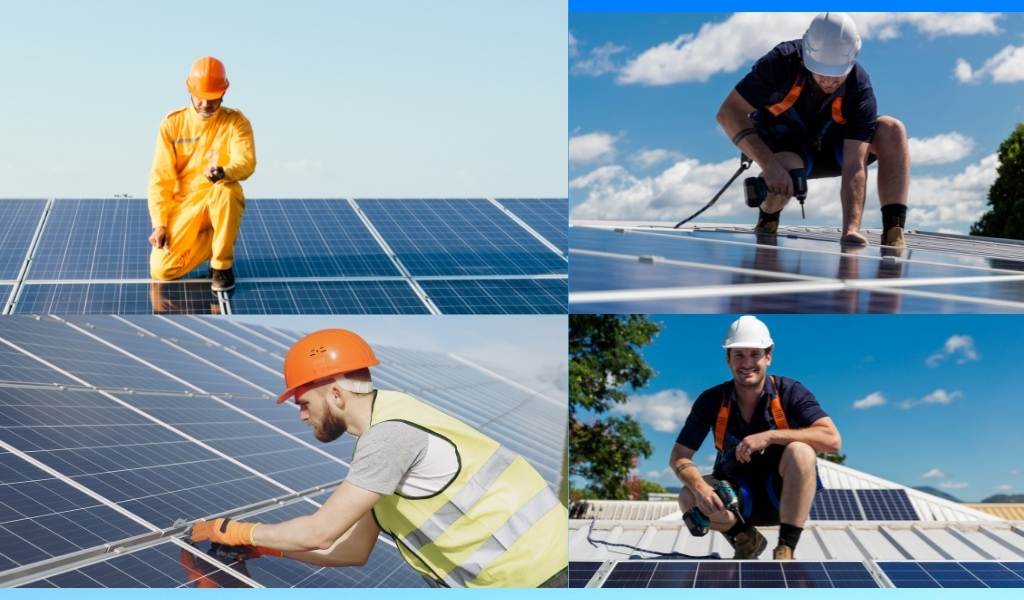About four-in-ten homeowners in the US have seriously considered going solar. Are you among those interested in switching to a system that provides clean, green energy? Those in the market for solar panels are usually surprised when they see the price tag. Even with the federal tax credit and other incentives, installing solar ain’t cheap.
To save money, some homeowners are considering the DIY route. But is it something that you can do yourself? To find out, let’s look at the solar installation process. See for yourself if it’s right up your alley or not.
Solar Installation Process – Step by Step
As you already know, the roof is the most common location for solar installation. That’s usually the area that receives the most sunlight. If, for some reason, you can’t or don’t want to install solar panels on your roof, mounting them on the ground is also an option. But make sure that no trees or buildings block the sun’s rays. The following are the steps involved in solar panel installation.
Choosing System Design and Size
Every property is different, and not every household has the same energy demands. The first step before investing a considerable amount in solar equipment is to evaluate your property.
If you’re dealing with a solar company, they’ll send someone for a general site visit. They’ll look at your roof and take measurements of your property to come up with the correct specs to recommend. They’ll also send an engineer to check the condition of your roof and electrical system.
If you want to do it yourself, you can look up solar panel calculators online. You can estimate the cost and size of the solar panels based on your location, energy consumption, and other factors. You can then decide on the best system for your needs, such as off-grid, hybrid, or grid-tied systems.
Purchasing Solar Equipment
The next step is ordering equipment and components. These include solar panels, inverters, batteries, racking, etc.
Your solar provider will often suggest a particular brand and alternatives for each. On your own, you need to do a bit of research. Compare brands based on durability, efficiency, or aesthetics, and choose the components that are right for you.
Installing Panel Mounts
It’s now time for some manual labor. Setting up your solar panels begins with mount installation.
For roof-mounted systems, scaffolding is essential for safety while working atop your roof. Fixing the mounts involve some drilling, caulking, and other physical work. As a DIYer, it’s crucial to be adept at these tasks since the racking and mounting support the solar panels.
The base structure needs a slight angle tilt, usually between 18 and 36 degrees. When installing the mounts, consider the direction the panels will face for maximum sunlight exposure. Those who live in the Northern Hemisphere (i.e., US homeowners) will want the panels to face south.
Installing the Solar Panels
The next part is attaching the solar or photovoltaic (PV) panels to the mounting structure. Most of the work involves tightening nuts and bolts. Take care to secure the panels for stability and lastingness.
Once you fit the panels to the mount, you’ll also need to connect a grounding wire across the rails. The wire serves as protection against lightning strikes and other electrical mishaps.
Wiring the Solar Panels
Wiring the individual solar panels to each other is the next step in the installation process. Remember to shut off your home’s electrical supply before doing any wiring.
Connecting the solar panels uses MC4 solar connectors. MC4 stands for “Multi-contact, 4 millimeters,” and it has become the solar industry standard.
Working with MC4s requires some specialized tools. A crimp tool that joins two metallic ends is the most important. A quality crimping tool ensures good grip and contact between the MC4 connectors and the electrical wiring.
Connecting the System to the Solar Inverter
The solar inverter is a device that converts direct current (DC) electricity to alternating current (AC). DC is what the PV panels generate, but it needs to be “inverted” to AC before your home’s electrical system can use it.
To connect the system to the inverter, attach the positive wire of the solar panel system to the positive terminal of the inverter. Repeat the procedure for the negative wire and negative terminal.
You can install the inverter indoors or outdoors as long as it’s near the main panel. When installing outdoors, it’s best to keep it shaded from the afternoon sun. Inverters are more efficient if kept cool while in operation.
Joining the Inverter and the Solar Battery
The solar battery stores energy produced by the panels for later use. That’s how you can keep your appliances running when it’s cloudy or during an outage. If your system and battery are big enough, your home can run exclusively on solar, letting you enjoy significant solar savings.
Joining the two units together is similar to attaching the panels to the inverter. Positive connects to positive, and negative connects to negative.
Connecting the Solar Energy System to the Grid
Before doing this step, arrange an inspection with your local authorities. They will ensure that your system complies with the required regulations.
After passing the inspection, you can connect the system to your home’s main electrical board. Your system is now in the grid. The local utility should provide a meter to monitor your system’s electrical production.
Start ‘Er Up!
Finally, it’s time to turn on your new solar panel system. Most inverter models allow you to see your unit’s generation and usage through a digital display. That’s how you’ll know that the system is fully operational.
Congratulations! Clean energy and considerable savings are now yours to enjoy for many years.
Can I Do It?
The answer is yes, you can, but is it worth it? In most cases, installation and labor costs are about ten percent of the total bill. When the average cost of going solar is about $20,020, the amount you’ll save by going DIY is tempting.
But if you’ve read this article, you’ll see that the solar installation process is very technical. Not a lot have the skills or equipment necessary to complete the project. Ultimately, it’s your decision whether it’s worth it or not.
Check out our technology section for more advice on this topic!

















